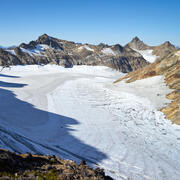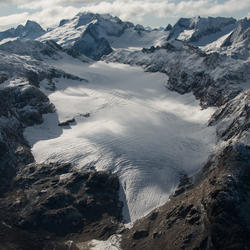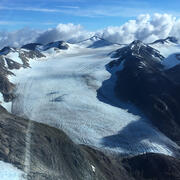Mass Balance Methods - Measuring Glacier Change
Nearly all Earth's alpine glaciers are losing ice, usually expressed as loss of mass. Rates of mass loss for North American glaciers are among the highest on Earth (Gardner, 2013) and shrinking glaciers are often the most visible indicators of mountain ecosystems responding to climate change.
Return to Glaciers and Climate Project
Nearly all Earth's alpine glaciers are losing ice, usually expressed as loss of mass. Rates of mass loss for North American glaciers are among the highest on Earth (Gardner 2013) and shrinking glaciers are often the most visible indicators of mountain ecosystems responding to climate change. Because shrinking glaciers impact downstream hydrological networks by changing the total discharge, flow regime, and chemistry of rivers and oceans, the USGS Glaciers and Climate Project's efforts to measure glacier change have national importance for understanding and adapting to pervasive ecosystem shifts driven by climate change. Within the program, a diverse suite of projects investigates glaciers from glacier-specific ice dynamics to regional impacts of glacier-climate interactions. Building upon long-term records of mass balance and embracing new technologies, the Glaciology Project is focused on understanding how glaciers respond to changes in climate. This understanding will help humans best predict and prepare for the local, regional, and global impacts of the ongoing changes to glaciers.
Mass Balance Methodology

Glaciers respond to variations in climate, primarily snowfall and temperature, by changing in length and thickness. Mass balance studies are the snow and ice accounting system for glaciers, quantifying this change to understand the relationship between climate change and glaciers. Mass balance of a glacier (also referred to as "surface mass balance") is the difference between the snow accumulated in the winter and the snow and ice melted over the summer. If the mass of snow accumulated on a glacier exceeds the mass of snow and ice lost during summer months, the mass balance is positive. Likewise, if summer melting exceeds what was gained in the previous winter, the mass balance of the glacier is negative.
What does mass balance mean?
Mass balance is a measure of a glacier's health. Over time, mass balance data reveal how glaciers are responding to climate. For example, by analyzing data collected on reference glaciers around the world from 1976 - 2005, the World Glacier Monitoring Service calculated glacier mass loss of over 20 meters of water equivalent, with average annual melting rates doubling after the year 2000 (UNEP, WGMS 2008). An even longer mass balance data record exists with the USGS Benchmark Glacier Research Project and shows a similar trend of mass loss for Gulkana and Wolverine Glaciers in Alaska (Van Beusekom et al, 2010). Documenting how glaciers are affected by climate change is helping to better understand how glacier change affects ecosystems and resources. Continued research will improve the accuracy of estimates of future glacier change that can guide decision-makers and stakeholders.

How is mass balance measured?
Traditionally, determining whether a glacier is gaining or losing mass involves measuring the change in mass at specific sites with snow stakes and snow pits, and then extrapolating these point values over the entire glacier surface. This method of measuring mass balance is field and labor intensive, consisting of repeated visits to sites dispersed along the glacier's elevation gradient in order to capture the difference in snow depth and density. Measurements are generally made twice annually, near the minimum mass of the season (fall) and the maximum mass of the season (spring), to determine seasonal mass gains and losses as well as the net change over the entire year.
Glaciers are made of several materials with different densities (given in units of kg m-3): snow that fell in the most recent winter (200-500 kg m-3), firn (snow from previous winters, 500-900 kg m-3) and ice (900 kg m-3). Because of these highly variable densities, average mass balance estimates for a glacier are presented in water-equivalent (w.e.) units. In this system, the densities and thicknesses of snow, firn and ice layers are first converted to water equivalent units. Then changes in mass balance are represented as a uniform water equivalent thickness over the entire glacier area.

Recent technological advances in remote sensing provide new opportunities to quantify how glaciers are changing. Image- and radar-based Digital Elevation Models (DEMs) provide 3D representation of a glacier's surface with meter-scale precision. DEMs allow field measurements to be extrapolated over the entire glacier. Moreover, repeat acquisitions over several years can be compared to determine total volume change of the glacier, which can be used to improve traditional stake and pit estimates of long-term mass balance trends.
The USGS Benchmark Glacier Research Project uses standardized glaciological field methods established by Østrem and Brugman (1991) and terminology established by Mayo and others (1972) in mass balance investigations.
Detailed descriptions of methods can be found in O'Neel et al, 2019.
South Cascade Glacier - Bidlake, Josberger and Savoca, 2010
Gulkana & Wolverine Glaciers - March and O'Neel, 2011
Sperry Glacier - Reardon, Harper and Fagre, 2008
How does glacier hydrography complement mass balance?
In addition to measuring mass balance, most benchmark glaciers record data on climate, glacier-motion, and stream-runoff to develop a better understanding of glacier-related hydrologic processes. Decades of instrumentation and field research at benchmark glaciers have resulted in recognition of glacier flow and climate change relationship, internal water storage in glaciers, and drainage patterns of sub-glacial water. Understanding of glacier dynamics continues as the ice and water balance of benchmark glaciers are further refined. Descriptions of each glacier and associated research is found under "Benchmark Glaciers" on this page.

How does mass balance research relate to regional impacts?
As changes in climate alter the size and extent of glaciers around the world, there will be impacts on water resources, sea level rise, physical and biological ecosystems, and social systems. From water supply issues for human consumption or aquatic species needs, to impacts on local recreation based economies, and ocean circulation, glaciers are linked to our lives on may levels. Mass balance studies, such as the USGS Benchmark Glacier Research Project, increase our understanding and predictive abilities to help adapt to the ecosystem shifts driven by climate change.
Glaciers and Landscape Change
South Cascade Glacier
Lemon Creek Glacier
Gulkana Glacier
Additional Research Glaciers
Wolverine Glacier
Sperry Glacier
Mass Balance Summary
Nearly all Earth's alpine glaciers are losing ice, usually expressed as loss of mass. Rates of mass loss for North American glaciers are among the highest on Earth (Gardner, 2013) and shrinking glaciers are often the most visible indicators of mountain ecosystems responding to climate change.
Return to Glaciers and Climate Project
Nearly all Earth's alpine glaciers are losing ice, usually expressed as loss of mass. Rates of mass loss for North American glaciers are among the highest on Earth (Gardner 2013) and shrinking glaciers are often the most visible indicators of mountain ecosystems responding to climate change. Because shrinking glaciers impact downstream hydrological networks by changing the total discharge, flow regime, and chemistry of rivers and oceans, the USGS Glaciers and Climate Project's efforts to measure glacier change have national importance for understanding and adapting to pervasive ecosystem shifts driven by climate change. Within the program, a diverse suite of projects investigates glaciers from glacier-specific ice dynamics to regional impacts of glacier-climate interactions. Building upon long-term records of mass balance and embracing new technologies, the Glaciology Project is focused on understanding how glaciers respond to changes in climate. This understanding will help humans best predict and prepare for the local, regional, and global impacts of the ongoing changes to glaciers.
Mass Balance Methodology

Glaciers respond to variations in climate, primarily snowfall and temperature, by changing in length and thickness. Mass balance studies are the snow and ice accounting system for glaciers, quantifying this change to understand the relationship between climate change and glaciers. Mass balance of a glacier (also referred to as "surface mass balance") is the difference between the snow accumulated in the winter and the snow and ice melted over the summer. If the mass of snow accumulated on a glacier exceeds the mass of snow and ice lost during summer months, the mass balance is positive. Likewise, if summer melting exceeds what was gained in the previous winter, the mass balance of the glacier is negative.
What does mass balance mean?
Mass balance is a measure of a glacier's health. Over time, mass balance data reveal how glaciers are responding to climate. For example, by analyzing data collected on reference glaciers around the world from 1976 - 2005, the World Glacier Monitoring Service calculated glacier mass loss of over 20 meters of water equivalent, with average annual melting rates doubling after the year 2000 (UNEP, WGMS 2008). An even longer mass balance data record exists with the USGS Benchmark Glacier Research Project and shows a similar trend of mass loss for Gulkana and Wolverine Glaciers in Alaska (Van Beusekom et al, 2010). Documenting how glaciers are affected by climate change is helping to better understand how glacier change affects ecosystems and resources. Continued research will improve the accuracy of estimates of future glacier change that can guide decision-makers and stakeholders.

How is mass balance measured?
Traditionally, determining whether a glacier is gaining or losing mass involves measuring the change in mass at specific sites with snow stakes and snow pits, and then extrapolating these point values over the entire glacier surface. This method of measuring mass balance is field and labor intensive, consisting of repeated visits to sites dispersed along the glacier's elevation gradient in order to capture the difference in snow depth and density. Measurements are generally made twice annually, near the minimum mass of the season (fall) and the maximum mass of the season (spring), to determine seasonal mass gains and losses as well as the net change over the entire year.
Glaciers are made of several materials with different densities (given in units of kg m-3): snow that fell in the most recent winter (200-500 kg m-3), firn (snow from previous winters, 500-900 kg m-3) and ice (900 kg m-3). Because of these highly variable densities, average mass balance estimates for a glacier are presented in water-equivalent (w.e.) units. In this system, the densities and thicknesses of snow, firn and ice layers are first converted to water equivalent units. Then changes in mass balance are represented as a uniform water equivalent thickness over the entire glacier area.

Recent technological advances in remote sensing provide new opportunities to quantify how glaciers are changing. Image- and radar-based Digital Elevation Models (DEMs) provide 3D representation of a glacier's surface with meter-scale precision. DEMs allow field measurements to be extrapolated over the entire glacier. Moreover, repeat acquisitions over several years can be compared to determine total volume change of the glacier, which can be used to improve traditional stake and pit estimates of long-term mass balance trends.
The USGS Benchmark Glacier Research Project uses standardized glaciological field methods established by Østrem and Brugman (1991) and terminology established by Mayo and others (1972) in mass balance investigations.
Detailed descriptions of methods can be found in O'Neel et al, 2019.
South Cascade Glacier - Bidlake, Josberger and Savoca, 2010
Gulkana & Wolverine Glaciers - March and O'Neel, 2011
Sperry Glacier - Reardon, Harper and Fagre, 2008
How does glacier hydrography complement mass balance?
In addition to measuring mass balance, most benchmark glaciers record data on climate, glacier-motion, and stream-runoff to develop a better understanding of glacier-related hydrologic processes. Decades of instrumentation and field research at benchmark glaciers have resulted in recognition of glacier flow and climate change relationship, internal water storage in glaciers, and drainage patterns of sub-glacial water. Understanding of glacier dynamics continues as the ice and water balance of benchmark glaciers are further refined. Descriptions of each glacier and associated research is found under "Benchmark Glaciers" on this page.

How does mass balance research relate to regional impacts?
As changes in climate alter the size and extent of glaciers around the world, there will be impacts on water resources, sea level rise, physical and biological ecosystems, and social systems. From water supply issues for human consumption or aquatic species needs, to impacts on local recreation based economies, and ocean circulation, glaciers are linked to our lives on may levels. Mass balance studies, such as the USGS Benchmark Glacier Research Project, increase our understanding and predictive abilities to help adapt to the ecosystem shifts driven by climate change.









